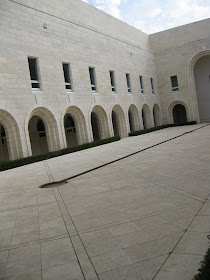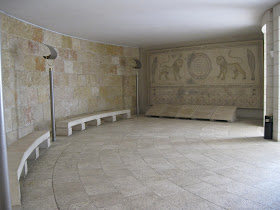.
This pillar is next to, but not part of, the Supreme Court Building.
The Hebrew on its top says
Nizkor, meaning We will remember.

Historian/artist/blogger
Abraham Lincoln asked me about the trials of Nazis in Israel.
Some information I found is so interesting I'd like to share it with you all.
.
Nazi war criminal Adolf Eichmann was captured in Argentina by Mossad agents in 1960 and was brought to Jerusalem for trial.
The only public place big enough for such a trial back then was Binyanay HaUma, the convention center.
.
He was found guilty of "crimes against the Jewish people" and "causing the killing of millions of Jews." Eichmann was executed by hanging.
The death penalty is reserved
only for such special cases as his.
In fact
Eichmann is the only one ever put to death by an Israeli court..The second crimes against humanity trial was when John (Ivan) Demjanjuk was extradited from Ohio to Israel in 1986.
The court found him guilty in 1988 and sentenced him to death by hanging.
He was placed in solitary confinement during the appeals process that followed.
.
But in 1993, five Supreme Court justices (sitting as the High Court of Justice) overturned the guilty verdict because new evidence had become available after the 1991 collapse of the Soviet Union.
This is the trial from which Abe Lincoln remembers seeing parts of our new Supreme Court Building on American TV.
.
The Israeli Supreme Court's 405-page ruling read:
"The main issue of the indictment sheet filed against the appellant was his identification as Ivan the Terrible, an operator of the gas chambers in the extermination camp at Treblinka . . . By virtue of this gnawing [new evidence indicating mistaken identity] . . . we restrained ourselves from convicting the appellant of the horrors of Treblinka. Ivan Demjanjuk has been acquitted by us, because of doubt, of the terrible charges attributed to Ivan the Terrible of Treblinka.
This was the proper course for judges who cannot examine the heart and mind, but have only what their eyes see and read." They also added: "The facts proved the appellant's participation in the extermination process.
The matter is closed — but not complete, the complete truth is not the prerogative of the human judge.".I find this remarkable, what the judges said!
And they refer to the Hebrew Bible references, e.g. Jeremiah 11:20, that have
God examining our "
heart and kidneys," usually translated as "the heart and mind."
The combination heart and kidneys is a Hebraism for the inmost part of the person .
.
Meanwhile, Demjanjuk returned to America, was stripped of his citizenship, and in May 2009 was extradited to Germany. His trial is now going on in Munich.
I don't like to recommend anything written about Israel by the BBC, but they do have a brief
slideshow explaining the various trials of Demjanjuk.
.
 In a post last week we talked about the symbolism of the water conduit in the Courtyard of the Arches.
In a post last week we talked about the symbolism of the water conduit in the Courtyard of the Arches. From up close you can see it has the vaulted ceiling and the other characteristics of Medieval Crusader buildings in Israel!
From up close you can see it has the vaulted ceiling and the other characteristics of Medieval Crusader buildings in Israel!














































